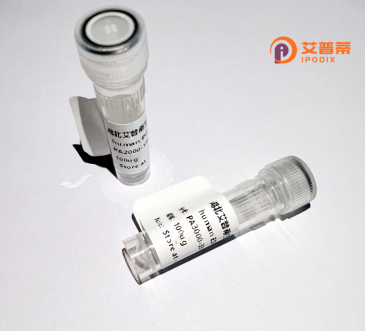
| 纯度 | >90%SDS-PAGE. |
| 种属 | Human |
| 靶点 | HSPC111 |
| Uniprot No | Q9Y3C1 |
| 内毒素 | < 0.01EU/μg |
| 表达宿主 | E.coli |
| 表达区间 | 1-178aa |
| 氨基酸序列 | MPKAKGKTRRQKFGYSVNRKRLNRNARRKAAPRIECSHIRHAWDHAKSVRQNLAEMGLAVDPNRAVPLRKRKVKAMEVDIEERPKELVRKPYVLNDLEAEASLPEKKGNTLSRDLIDYVRYMVENHGEDYKAMARDEKNYYQDTPKQIRSKINVYKRFYPAEWQDFLDSLQKRKMEVE |
| 分子量 | 45.32 kDa |
| 蛋白标签 | GST-tag at N-terminal |
| 缓冲液 | 0 |
| 稳定性 & 储存条件 | Lyophilized protein should be stored at ≤ -20°C, stable for one year after receipt. Reconstituted protein solution can be stored at 2-8°C for 2-7 days. Aliquots of reconstituted samples are stable at ≤ -20°C for 3 months. |
| 复溶 | Always centrifuge tubes before opening.Do not mix by vortex or pipetting. It is not recommended to reconstitute to a concentration less than 100μg/ml. Dissolve the lyophilized protein in distilled water. Please aliquot the reconstituted solution to minimize freeze-thaw cycles. |
以下是关于重组人HSPC111蛋白的相关文献概览:
1. **"HSPC111 regulates cell proliferation in hepatocellular carcinoma"**
*作者:Li X, Chen Y, Wang J*
摘要:研究揭示HSPC111在肝癌组织中高表达,重组人HSPC111蛋白的过表达可通过激活PI3K/AKT通路促进肝癌细胞增殖,提示其作为潜在治疗靶点。
2. **"Characterization of recombinant human HSPC111 in ribosome biogenesis"**
*作者:Zhang R, Liu F, Patel SV*
摘要:研究利用重组HSPC111蛋白证实其参与核糖体RNA加工,通过RNA干扰实验发现其缺失导致核仁功能紊乱,揭示了其在核糖体合成中的关键作用。
3. **"Prognostic significance of HSPC111 in colorectal cancer"**
*作者:Guo L, Shi H, Xu D*
摘要:重组HSPC111蛋白的高表达与结直肠癌患者预后不良相关,实验表明其通过调控Wnt/β-catenin信号通路促进肿瘤侵袭转移。
4. **"Development of an anti-HSPC111 monoclonal antibody for cancer detection"**
*作者:Kim S, Park JH, Lee M*
摘要:研究利用重组HSPC111蛋白开发特异性抗体,验证了其在多种癌症组织中的高表达,并证明该抗体可作为早期癌症诊断的生物标志物探针。
注:HSPC111(又名UTP18)常与核糖体合成及肿瘤进展相关,以上研究聚焦其重组蛋白在分子机制及临床应用中的价值。
**Background of Recombinant Human HSPC111 Protein**
The human HSPC111 protein, also known as C14orf166 or RAE1-interacting protein, is a conserved nucleolar protein implicated in ribosome biogenesis and RNA metabolism. Initially identified through its interaction with the RNA export factor RAE1. HSPC111 plays a role in cellular processes such as cell cycle progression, proliferation, and stress responses. Structurally, it contains a coiled-coil domain critical for protein-protein interactions and is localized predominantly in the nucleolus, suggesting its involvement in rRNA processing or assembly of ribosomal subunits.
HSPC111 has gained attention due to its dysregulation in cancers. Overexpression is observed in hepatocellular carcinoma, colorectal cancer, and gliomas, correlating with poor prognosis and tumor aggressiveness. It may promote oncogenesis by enhancing cell survival, inhibiting apoptosis, or modulating pathways like p53 signaling. Furthermore, HSPC111 interacts with viral proteins during infections, potentially influencing host-pathogen dynamics.
Recombinant human HSPC111 protein is produced using bacterial (e.g., *E. coli*) or mammalian expression systems, enabling studies on its biochemical properties, interactome, and functional mechanisms. It serves as a tool for antibody development, *in vitro* binding assays, and screening therapeutic agents targeting cancer or viral infections. Current research focuses on unraveling its precise roles in ribosome assembly and exploring its potential as a diagnostic biomarker or therapeutic target.
×